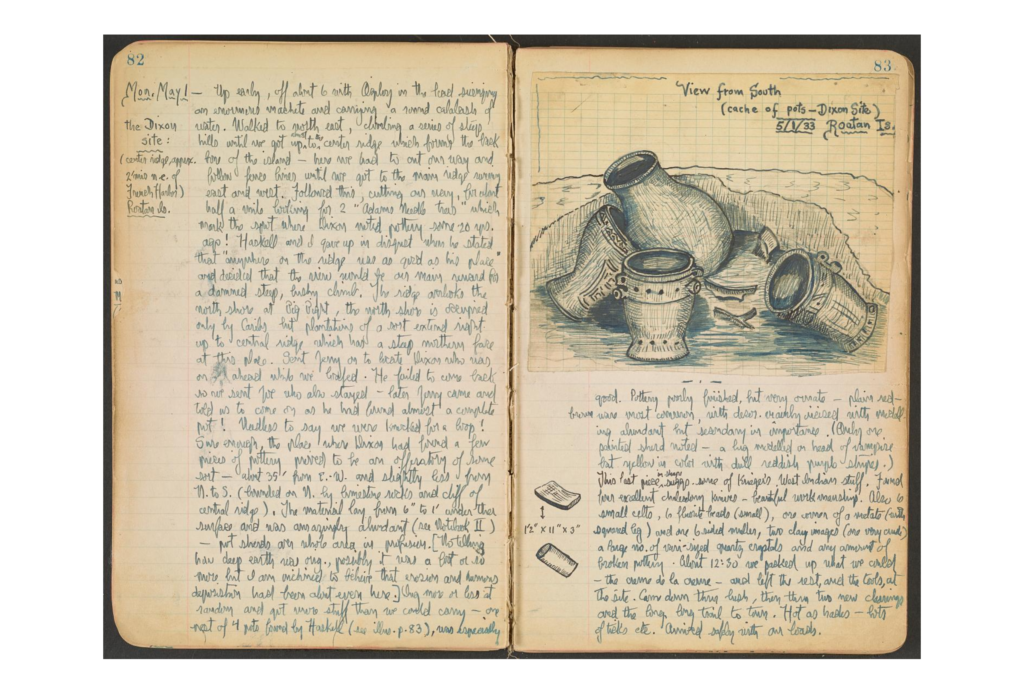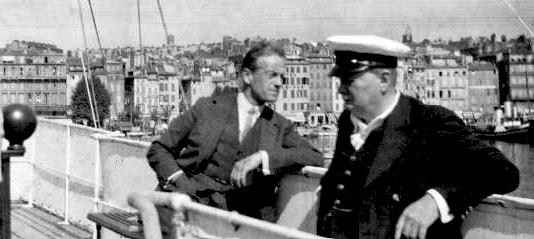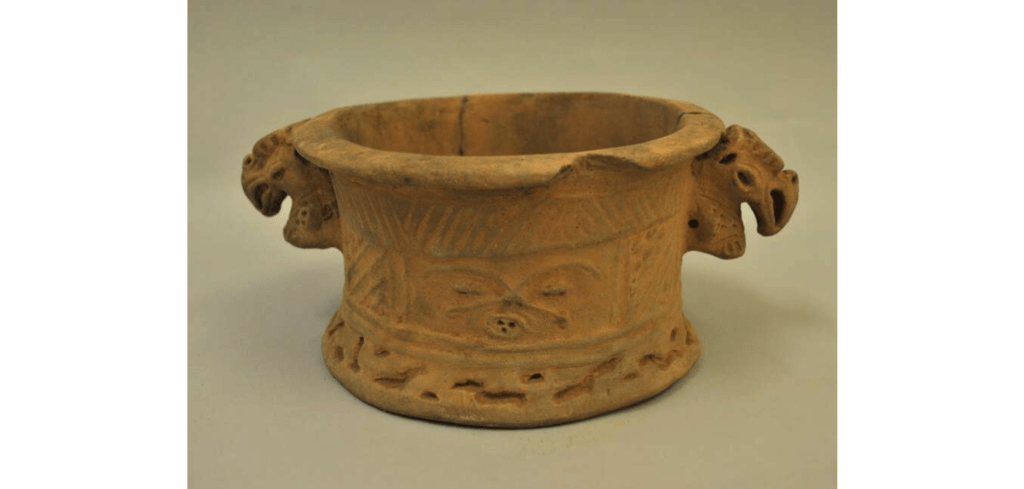This article is not about ‘Mike’ Mitchell-Hedges but he always seems to makes it to the beginning of any story about contemporary Anglo-Bay Islands history. Probably because this enigmatic adventurer brought excitement to any venture he was a part of. Nobody knew the real Mitchell-Hedges nor could anyone vouch for the veracity of his tales . A good example being that of his famed Chrystal Skull of Lubaantun ( Belize ) which he disclosed later had actually been discovered in a dank St. Helene cave but it didn’t quite carry the same ring as being unearthed in a Mayan ruin. He lived on his boat , the Amigo , anchored off Rocky Point , Helene for several years in the late 1920’s until one day ( in his own words ) his fellow explorer , Dr. Ball , surveying on Bailey’s Cay observed his compass needle spinning wildly ; calling Mike they dug down and discovered 4 chests loaded with doubloons and jewelry which they re-crated as Indian Artefacts and fled the Islands in haste. Once in America it was purported that he sold all the booty for $6million and set himself up on a speaking tour of the US , Canada and Britain.

Frederick Albert ‘Mike’ Mitchell-Hedges ( 1882-1959 )
While on this speaking tour the account of his amazing ( some would say far-fetched )discoveries in the Bay Islands ( St. Helene and Barbarat specifically ) brought the attention of professional Archeologists particularly of his claims that the artefacts were the remains of the lost city of Atlantis , some 25,000 years old . The first serious Archeaological trip was the Boekelman shell heap expedition of 1931 ( which focused on shell heaps or middens as an indication of population centres. The most fascinating and well documented expedition was the Duncan Strong trip of April and May of 1933 to Utila ( the Indian well and stone causeway features ), Roatan ( Dixon Hill site ) , Port Royal , St. Helene , Barbarat , Morat and Bonacca . His notebook is quite a delight to read with some beautiful sketches of flora and fauna as well as artefacts found at the sites ; a delightful combination of Natural History and Archeaology . Strong’s expedition had a distinct advantage in that he used the same vessel ( the MV Amigo bequeathed by Mitchell-Hedges to his friend , the wooden legged Captain Frank Boynton ) and with it the same crew , Gerald Bodden and Joe Solorzano that had accompanied Mitchell-Hedges a few years prior. On Roatan , he explored a site on a hill East of French Harbour on Dixon land accompanied by Ogilvy Dixon which he called Dixon Hill.

Strong’s book which was the fruit of his 1933 expedition , “ Archaeological Investigations in the Bay Islands , Spanish Honduras “ is still to this day considered the starting point for any archaeological or anthropological study of Bay Islands pre-Columbian history more significantly because Strong was not only an academic with a Phd but an Americanist through and through. Widely considered to have taken modern Archaeology to Columbia University where he was Chairman of the Department of Anthropology for many years. An assiduous field worker and important theorist he was not a showman like Mitchell-Hedges and as a result his journal and book provided us with a trove of information of our Bay Islands history that was the basis for the other two expeditions that were to take place in 1938 and 1939 ; William Duncan Strong’s contribution was of such significance that I will dedicate my next article to his expedition and subsequent discoveries.
At about the time that Duncan Strong was exploring the hills and caves of the Bay Islands , Walter Edward Guinness , 1st Baron Moyne was completing purchase of the SS Dieppe and fitting it out as a diesel powered private yacht to be named MY Rosaura. Guinness was a soldier ( veteran of both Boer War and Great War ) and businessman famous for building the Guinness brewing empire in Dublin his grandfather had started as well as Conservative politician . More significantly in politics he was a close friend of Winston Churchill who was actually one of his first guests on the Rosaura , together with his wife Clementinein the summer of 1934 to Greece and Beirut ; later that year the Prince of Wales ( the abdicated King Edward VIII ) and Wallis Simpson were his guests where Wallis later wrote that their voyage together on the Rosaura in the Mediterranean was where she grew to love Edward.

Lord Moyne and Winston Churchill on MY Rosaura in 1934 ( 5 years before the start of World War II ) when Churchill was merely the MP for Epping and Guinness in the House of Lords.
Lord Moyne had been involved in politics since the age of 27 in a career that spanned some thirty-seven years taking him from Member of Parliament to the House of Lords and five cabinet positions primarily during the Churchill wartime leadership. It was politics that brought him to the Caribbean , appointed by Neville Chamberlain as Chairman of the West Indies Royal Commission in 1938 . There had been widespread labour unrest in the British Caribbean and Moyne had been appointed to spearhead reforms in the region. Being the explorer and artefact “ collector” ( if he wasn’t an aristocrat he would be called a looter ) it was an obvious choice for him to travel in his boat , MY Rosaura and it was on her that he made one trip in 1938 and one in 1939 to the Bay Islands. He had read Strong’s Journal which appealed to him as well as Mitchell-Hedges “Land of Wonder and fear “ ( of which prominent Archeaologist , Eric Thompson commented : “ to me the wonder was how he could write such nonsense and the fear of how much taller the next yarn would be “ )
Using Captain Frank Boynton ( who had accompanied Mitchell-Hedges ) as his pilot as well as ‘Spanish Joe’ Savas Solorzano and Gerald Bodden both from Diamond Rock as crew the Moyne expedition of 1938 didn’t spend much time on Utila or Roatan but made it straight to Helene where he hooked up with Thomas and Herbert Forbes who helped tremendously in revictualing the Rosaura and served as guides on Helene and Morat together with Cleveland Bodden and his two sons , Marwick “ Butterfly “ Bodden and Telford Bodden. I should mention that I knew ‘Uncle’ Butterfly for the last few years of his life and gleaned much of Helene’s history from listening to him. The sites that Moyne and group excavated extensively were on the three peaks of Indian Hill on Helene. Over a thousand pieces were removed from this area and now sit in the British Museum and can be viewed on their website. Some quite unique painted ollas with tripod legs typical of artefacts found in the Ulua valley tell of a distinct link between the Bay Islands Payan Indians and the settlements in Ulua. On board the Rosaura for the 1938 expedition was the renowned Zoologist , H W Parker CBE, keeper of Zoology of the British Museum who discovered and named a new species of Gecko , the Bay Islands Least Gecko or its latin name Sphaerodactylus Rosaurae ( in honour of the Rosaura ). Lord Moyne’s patronage and Parker’s association with the British Museum would explain why all of Moyne’s pieces from all over the world ( not only Honduras ) ended up here.

A Tripod Olla with Manatee handles found on Indian Hill , Helene and removed to London where it is now on display in the British Museum

Bay Islands Least Gecko – ‘Sphaerodactylus Rosaurae’ Discovered by Dr. H W Parker and named after the MY Rosaura
In the summer of 1939 , R W ‘Dickie’ Feacham an Archeologist ( more of a collector ) who had accompanied Lord Moyne on a prior expedition to Greenland had managed to arrange backing from the Royal Geographical Society and the Faculty of Archeology at Trinity College , Cambridge. The Rosaura was to be used with Lord Moyne tagging along from Jamaica , no doubt to clean up where he had left off with his looting of Indian Hill on Helene. This was the summer of 1939 and war clouds were gathering in Europe and it was rumoured that Moyne’s close friend , Winston Churchill would replace Neville Chamberlain as Conservative leader ( wartime Prime Minister as it turned out ) and would likely call upon him to serve in his cabinet. But not only impending war but the sudden death of his wife , Lady Evelyn Stuart on the 31st of July , 1939 forced Lord Moyne to leave for England on the Rosaura , leaving Feacham and entourage to continue on the Amigo , Capt. Frank Boynton’s vessel which was used by Mitchell-Hedges in 1927. The expedition started in Utila for a brief stay retracing the steps of Junius Bird and William Waterhouse’s expedition of 1929 for the Smithsonian where they re-visited the Indian well , a stone causeway and a number of urn burial sites with local guide , Eddie Whitefield.
From Utila they ventured west roughly following Strong’s expedition trail of 1933 stopping at Pollatilla ( as Feacham called it ) and Punta Gorda where they observed “… their village with it’s thatched huts and cows and pigs , was like Wiltshire with Palm Trees. “ . On Helene , joined by Cleaveland Bodden and his sons Butterfly and Telford , Feacham and crew explored the caves that Strong had explored in 1933 that bordered the mangrove canal and where Mitchell Hedges had supposedly found the Chrystal Skull. A visit to the Indian Hill site noted nothing but shards of pottery that Moyne had left behind the year before . Further west on Barbarat guided by plantation men Wesley and Brindley Cooper they made the long trek up Pear Tree Gully to Indian Hill where they found a few pieces particularly a large egg shaped vessel with three legs and a hole at the bottom. The expedition finished at Bonacca where they met up with Professor Colin Pinckney from Cambridge University who , together with Derek Leaf were surveying the Plan Grande , walled site .
And what of Lord Moyne and MY Rosaura ?
In 1941 the Rosaura was commissioned by His Majesty’s navy as a boarding vessel and became HMS Rosaura and a few months later on the 18th March struck a mine off Tobruk and sunk taking with her 78 souls. Lord Moyne was appointed leader of the house of Lords in February 1941 and Secretary of State for the colonies until February 1942 when he was appointed by Churchill as British Minister Resident for the Middle East in Cairo , Egypt where he served until he was assassinated by the members of the Jewish ‘ Lehi ‘ terrorist group in November , 1944 together with his driver. This actually was the beginning of the end for the British in Palestine and Winston Churchill for once in his life took sick upon hearing of his friend’s death and was unable to address parliament.
The Moyne Collection can still be found at the British Museum and would , I suspect be well worth the effort to try and repatriate back to Roatan for display in a future Museum here. The Rosaura is in 200ft of water off Tobruk and its namesake the Sphaerodactylus Rosaurae still moping around the forests of Roatan munching on insects.

( photo taken during the First War when she was HMS Dieppe and used as a hospital ship )
